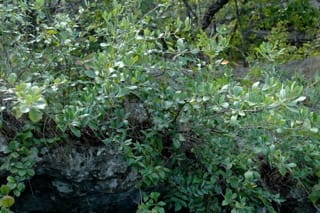This guide initially displays common trees of all shapes. Use the selectors below to view particular shapes, include rare species, or search by name.
Growth of trees in the Southwest largely depends on temperature and moisture. In general, temperature is lower at higher altitudes, moisture is greater. As altitude affects temperature and moisture, it largely determines the distribution of tree species in this area.
Los Alamos County and surrounding areas include three main vegetation zones. The Pinyon-Juniper Woodland (4500 – 7500 ft; 1375 – 2300 m) is characterized by pinyon pine, one-seed juniper, alligator juniper and Rocky Mountain juniper. The Ponderosa Pine Forest (5500 – 8500 ft; 1700 – 2600 m) consists mainly of ponderosa pine. The Spruce-Fir Forest (8000 – 12000 ft; 2500 – 3650 m) includes Douglas fir, white fir, quaking aspen, limber pine, and, at higher altitudes, Engelmann spruce and subalpine fir. Little (Southwestern Trees: A Guide to Native Species in New Mexico and Arizona [PDF]) describes these zones in more detail.
Two recent catastrophic wildfires (Cerro Grande Fire in 2000, Las Conchas Fire in 2011) burned large areas of Los Alamos County. The burned areas now support fast-growing pioneer species rather than the slow-growing trees that characterize the vegetation zones. What was Pinyon-Juniper Woodland is now largely grassland; what was Ponderosa Pine Forest is now largely grass, Gambel oak, and quaking aspen; what was Spruce-Fir Forest is now largely grass and quaking aspen. Vegetation in these areas will change as succession proceeds.
This guide describes many of the native species of trees in and around Los Alamos County. It also includes a few introduced species that are often seen in the wild. More detailed information can be found in Plants of the Jemez Mountains Volume 1, which is available in the PEEC gift shop.
Tree References
American Trees – Big Trees Project
Arbor Day Foundation
Kershner, B, Mathews, D, Nelson, G, Spellenberg, R, 2008
National Wildlife Federation Field Guide to Trees of North America.
Sterling Publishing Company
Sibley. D.A., 2009 The Sibley Guide to Trees. Alfred A. Knopf, Inc.
Flora of North America
Encyclopedia of Life
Lady Bird Johnson Wildflower Center
SEINet
Spellenberg, R., Earle, C.J., Nelson, G., 2014 Trees of Western North America.
Princeton University Press
Southwestern Trees: A Guide to Native Species in New Mexico and Arizona, 1968
Agriculture Handbook No. 9, United States Department of Agriculture [PDF]
Foxx, T., Martin, C., and Hoard, D., 2016 Plants of the Jemez Mountains Volume 1:
Tree, Shrubs, Vines, Ferns, and Horsetails. All Seasons Publishing
US Department of Agriculture National Resources Conservation Services
Subject Area Experts (all guides)
Steve Cary (butterflies)
Beth Cortright (insects)
Terry Foxx (invasive plants)
Leslie Hansen (mammals)
Richard Hansen (fish, mammals)
Dorothy Hoard (butterflies, trees)
Chick Keller (flowers, herbarium)
Shari Kelley (geology)
Kirt Kempter (geology)
Garth Tietjen (reptiles)
David Yeamans (birds)
Web Development and Content Management
Pat Bacha
Jennifer Macke
Graham Mark
Akkana Peck
Contact
Please contact us for local nature questions and sightings. We welcome comments, corrections, and additions to our guides.
For more information about local nature, please visit our Nature Blog or subscribe to PEEC This Week.
Make Selection
 Photo: nancyed  Photo: Cory Maylett |  Mountain Mahogany, Silverleaf, Alderleaf Mountain MahoganyCEMO2 (Cercocarpus montanus)Family: Rosaceae (Roses) Size: 8 - 20 ft (2 - 6 m) Growth: shrub, tree; perennial Status: native; common Habitat: dry rocky hillsides, cliffs, open woods, mesas at eleavtions of 3,500 to 8,000 ft (1,100 to 2,400 m) This shrub or small tree has leaves that are dark-green leaves on top and fuzzy underneath and remain on the tree for most of the year. Non-showy flowers are followed by feathery, silvery-white fruits during the summer and fall. Info Photos Range Flower Guide |
